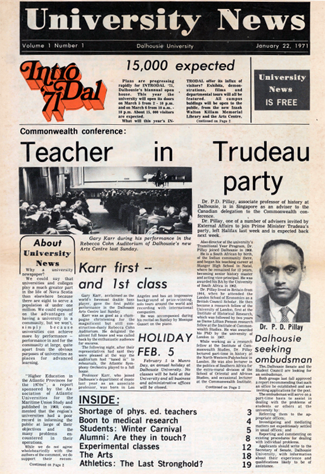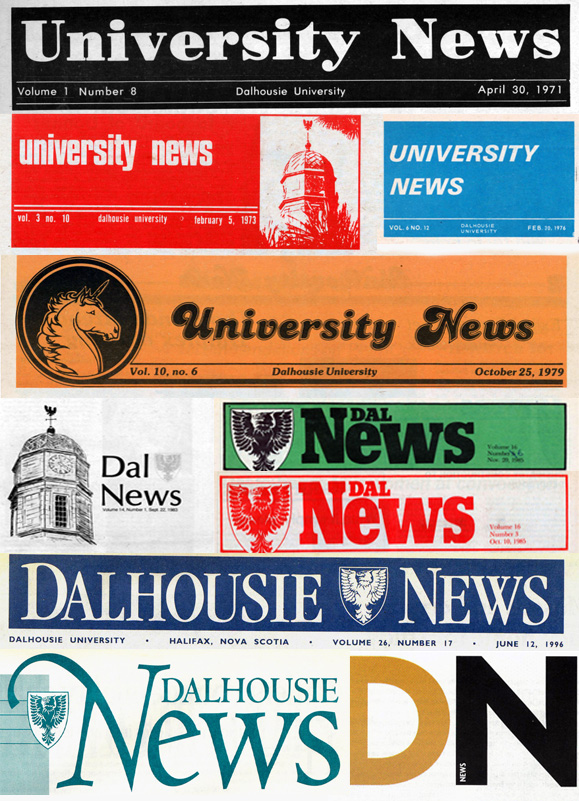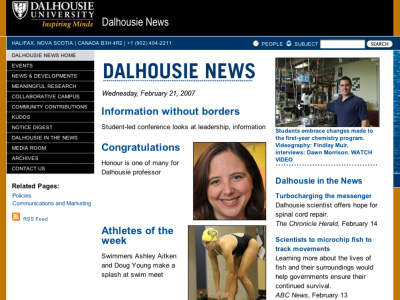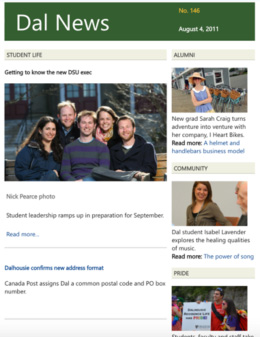Trudeau is the prime minister. HÂţ» is focused on expanding experiential learning. Parking is a campus issue with “no easy answer.”
Headlines from 2021? Possibly. Except that, right alongside, you also find news stories about the construction of the Life Sciences Centre, the launch of the Department of Oceanography and a story about Dal’s enrolment that cites a new record total of 6,616 students — less than a third of what enrolment is today. Oh, and no mention of COVID-19 at all.
 Welcome to January 1971, a time when there was no Internet, when HÂţ» had only two campuses, and when the first issue of University News — the publication now known as Dal News — was hitting newsstands on campus and across Halifax.
Welcome to January 1971, a time when there was no Internet, when HÂţ» had only two campuses, and when the first issue of University News — the publication now known as Dal News — was hitting newsstands on campus and across Halifax.
This month marks 50 years of Dal News being part of the HÂţ» community — a black-and-golden anniversary, if you will. Through more than 600 printed newspapers, 7,300 online articles and 416 weekly email digests, Dal News has been there, sharing the stories of HÂţ»â€™s people, events and happenings for half a century.
A lot has changed over that time. Dal News has covered six HÂţ» presidents and seven chancellors; seen generations of faculty, staff and students come through the halls of campus, transforming the university and its mission; and witnessed mergers with other schools and expansions into other provinces that have grown HÂţ»â€™s scope and impact. Another marker of time’s passage: a student who picked up that first issue on campus in 1971 would now be in their seventies.
But for all that’s different, there’s plenty of familiarities to be found in the fonds of the Dal News archives: recurring events and celebrations that still take place today; issues and concerns that repeat in new ways across the decades; and, above all else, a sense of how the heart of the HÂţ» community remains the dedication and drive of the people who work and study here.
In the midst of a truly historic era of our own — during which the work of the university is being done like never before — we didn’t want to let this small marker of history go by without a bit of reflection and celebration. As part of our anniversary coverage, here’s a little look back at the genesis of University News and its evolution into Dal News today.
The origins
Dal News is one of many ways that people who study and work at the university have gotten news and information over the years. Other news sources include the student-run HÂţ» Gazette — which, with over 150 years of history, holds claim to being the oldest student newspaper in North America — and the many internal newsletters that have long been published by departments and Faculties.
So, what inspired the university to establish its own newspaper alongside these in 1971? Well, it starts with government.
The late 1960s was one of several times in modern history when the idea of more formal union of the Maritime provinces was picking up steam. As part of a study commissioned in 1968 towards this goal, the Association of Atlantic Universities published a report titled Higher Education in the Atlantic Provinces for 1970. Among its findings was a conclusion that the region’s universities needed to do a better job informing the public about their goals and their challenges. In 1970, this feedback was picked up and amplified by the Nova Scotia government, with the chairman of the province’s grants committee — the body which recommended the level of financial support to universities — urging the province’s universities to do more to tell their story and improve their public image.
 That background helps explain a couple of things about University News that might surprise modern readers of Dal News. First, even though the publication was about university news and events, it was also aimed at readers beyond campus borders: the initial press run of 15,000 copies included 5,500 copies sent to Sobeys, Lawtons, Scotia Square and other locations across Halifax for passersby to pick up (see the listing to the right), as well as a mailing of 4,500 issues to local alumni. (Subsequent issues scaled total distribution back to about 10,000.) Secondly, its title — University News — reflected an aim to tell stories not just about HÂţ», but other Nova Scotia schools too. Though it was a Dal venture, its pages were “open to news and views from or about other universities in the province” and the publication would “report any news of higher education its editors believe to be of general interest.”
That background helps explain a couple of things about University News that might surprise modern readers of Dal News. First, even though the publication was about university news and events, it was also aimed at readers beyond campus borders: the initial press run of 15,000 copies included 5,500 copies sent to Sobeys, Lawtons, Scotia Square and other locations across Halifax for passersby to pick up (see the listing to the right), as well as a mailing of 4,500 issues to local alumni. (Subsequent issues scaled total distribution back to about 10,000.) Secondly, its title — University News — reflected an aim to tell stories not just about HÂţ», but other Nova Scotia schools too. Though it was a Dal venture, its pages were “open to news and views from or about other universities in the province” and the publication would “report any news of higher education its editors believe to be of general interest.”
Read also: Inside Volume 1, Number 1: Flipping through the pages of the first‑ever edition of Dal News
As you might expect, given that this publication isn’t called University News today, that second aim never quite came to fruition. Over time, those other submissions never quite added up, and the publication’s content mix ended up mostly HÂţ» news and events. Two years after that first issue, a familiar clock tower was already showing up in the masthead; by 1983, the publication formally updated its name to become Dal News. At that point, its audience and mission was more focused: a publication “for faculty, staff and students,” “full of news and features about HÂţ» and Dalhousians.”
Through the years
Yet even if aspects of its focus and scope shifted over time, there’s a lot about that original University News mission statement still resonates: it hoped to “tell the story of universities — particularly HÂţ» — and of their efforts in and for the community, and of their students and staff and achievements and problems,” and in doing so “present a fair and accurate picture of university life and work.”
keeps a collection of Dal News, and . Browsing through the digital scans is like flipping through a scrapbook from another era — one in which you can see the HÂţ» you know today coming together, piece by piece.
In fall 1971, for example, Dal News covered the launch of the HÂţ» Arts Centre (also marking its 50th anniversary in 2021) as a “major asset to community.” In 1973, the focus was on how “HÂţ» needs a new physical education, recreation and sports centre” — the start of a discussion that, after much turmoil (including a Supreme Court case!) would lead to the building and opening of Dalplex. Rising labour issues in the late 1970s prompted faculty to vote to unionize the HÂţ» Faculty Assocaition — which passed by a mere 48 votes. In 1985, Dal News announced, “Dal and Agricultural College affiliate” — a relationship that, 27 years later, would lead to a merger of the two institutions and the establishment of Dal’s Agricultural Campus in Truro.
Other headlines are decidedly more of their time. A 1976 cover touted “Dal-Soviet pact signed,” a new exchange program made possible thanks a cultural agreement between the Canadian and USSR governments. In 1985, Dal News celebrated a “New administrative computer in place” — yes, one computer, at a cost of a million dollars, poised to handle student records, financial services and personnel payroll. One of the more strikingly dissonant covers is the publication’s first issue as Dal News in September 1983, featuring a campus meeting between then-president Alexander MacKay and Zimbabwe Prime Minister Robert Mugabe — who, at the time, was a celebrated world leader on a high-profile state visit to Canada, not the notorious dictator he would later become.
The look and feel of Dal News changed a lot through all this. Though most of the publication was printed in black and white, the masthead was frequently coloured red, green, blue and even orange (not an official HÂţ» colour). It included various versions of the HÂţ» shield, the iconic Henry Hicks clock tower and, for a while, even a unicorn head — which may seem a particularly odd choice until you look more closely at the HÂţ» Seal and its inclusion of the unicorn from Ramsay Clan Coat of Arms (the clan from which university namesake Lord HÂţ» was from).

Print mastheads through the years
Going digital
Through all its various looks, Dal News — which extended its name to “HÂţ» News” beginning in 1989 through to the mid-2000s — generally kept a consistent print schedule for most of its history. Newspapers were published biweekly through the school year, alongside occasional special issues, often taking the spring and summer off.
That all changed forever in 2004 when Dal’s communications team decided to move Dal News entirely online. No longer beholden to print deadlines, Dal News could post articles regularly, whenever they were fit to publish. What’s more, now unbound by physical access to a nearby newsstand, the stories of Dal’s students, faculty, staff and alumni were now available to readers clicking through from around the world.
 At first, the digital Dal News published small but steadily — a few stories a week most of the time. Within a few years that output had doubled, and by the turn of the decade the Dal News team was regularly churning out 500 or more stories a year. (Pictured is the site's homepage in 2007.) Contributors included not just the editor and staff from the communications office, but other writers from across campus — including a team of student writers.
At first, the digital Dal News published small but steadily — a few stories a week most of the time. Within a few years that output had doubled, and by the turn of the decade the Dal News team was regularly churning out 500 or more stories a year. (Pictured is the site's homepage in 2007.) Contributors included not just the editor and staff from the communications office, but other writers from across campus — including a team of student writers.
Yet the move to online didn’t fully spell the end of Dal News in print. In the winter of 2007, a short-run print edition was produced as part of an effort to promote awareness of a referendum on funding new student spaces. That one-off issue was well-received institutionally, and so for the next few years, during the fall and winter terms, the Communications, Marketing and Creative Services team would put together a monthly edition of Dal News in print — with stories that were fresh when the issue hit newsstands and would later filter online alongside more immediate “breaking news” stories.
 That arrangement lasted until 2010, when Dal News returned to a fully online publication — and continued to find new ways to bring stories to the Dal community and beyond. The university’s first Twitter account was @DalNews, a handle it carried for years until becoming @HÂţ»U in 2018. Dal News stories soon came with social media links, allowing them to be shared instantly via any platform of choice. And in 2011, the Dal News Weekly newsletter was launched — for the first time bringing a digest of all the week’s stories to the email inboxes of all students, faculty and staff.
That arrangement lasted until 2010, when Dal News returned to a fully online publication — and continued to find new ways to bring stories to the Dal community and beyond. The university’s first Twitter account was @DalNews, a handle it carried for years until becoming @HÂţ»U in 2018. Dal News stories soon came with social media links, allowing them to be shared instantly via any platform of choice. And in 2011, the Dal News Weekly newsletter was launched — for the first time bringing a digest of all the week’s stories to the email inboxes of all students, faculty and staff.
Here we are today
Today, the work of Dal News continues, even in the midst of a global pandemic. Last year, we published 491 stories to our website, attracting more than 420,000 visitors — 120,000 of them from countries as varied as the U.S., India, the UK and the Philippines. It’s a reach that couldn’t even be imagined when University News first hit newsstands five decades ago.

Photo highlights from 2020 stories.
Having served as editor of Dal News for 10 of those 50 years — and having had the privilege of knowing and learning from a few of the editors who came before me as well — I’ve borne witness to how the work of telling HÂţ»â€™s stories has shifted and changed through a modern, digital era. There are some things we undoubtedly do better today: stories are more immediate, can explore topics in greater depth and length, and extend outwards into the Dal community and our world like never before.
There are also aspects of the tone, style and substance of University News and Dal News past that I’m envious of — in particular, the way those versions strove for a broad comprehensiveness in profiling university news and events. Today, no one publication is expected to be everything to everyone. Instead — with our personal content feeds chopped, customized and filtered across platforms, and with readers engaging on all sorts of devices — it can sometimes feel like news websites of all stripes are just trying to put out good stories and do whatever they can to help them find their way to people.
As I hand off editorial duties to my colleague Matt Reeder (who has been making spectacular contributions to this site for several years now), I think back on something I’ve often told new writers contributing to Dal News for the first time: that HÂţ» is a community of students, scholars and staff that is always exceptionally busy — doing and thinking and learning, non-stop. Any time they take to read and learn about something other than what’s right at the top of their to-do list at any given moment is a gift to be appreciated and respected. Our responsibility, then, as Dal News, is to give them something that makes those few minutes of time they give us worthwhile, before letting them return to what they’re really here for, back to studying, discovering, supporting one another.
I hope you’ve found something worth your while here at Dal News over the years, and here’s to many more years of great HÂţ» stories to come.

